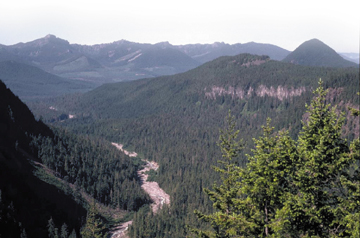 A new field study
has confirmed what models had previously predicted: The intense heat of wildfires
can reset the helium "clock" in rocks, making them appear younger
than they are. Although the finding could complicate a recently developed popular
dating technique using helium, it demonstrates a new application for the technique
— mapping out past wildfires.
A new field study
has confirmed what models had previously predicted: The intense heat of wildfires
can reset the helium "clock" in rocks, making them appear younger
than they are. Although the finding could complicate a recently developed popular
dating technique using helium, it demonstrates a new application for the technique
— mapping out past wildfires. Here in the Cascade Range of Washington, researchers are studying the effects of wildfire on a popular technique for dating rocks. Copyright Jerome Wyckoff, courtesy of Earth Science World ImageBank.
Helium, a byproduct of the radioactive decay of uranium and thorium, diffuses out of rocks at high temperatures as fast as it is formed. However, at low temperatures such as those found at shallow depths in Earth's crust, the crystal structures of certain minerals will close and helium will start to accumulate inside. The mineral apatite has a closure temperature of 70 degrees Celsius, which occurs about 2 to 3 kilometers below the surface, while zircon's closure temperature is about 180 degrees Celsius. Assuming a relationship between temperature and depth, measuring the amount of helium that has accumulated in apatite or zircon grains can tell scientists when and how fast bedrock was uncovered by erosion — in a dating method called helium thermochronometry.
"When we measure helium ages," says Sara Gran Mitchell of the University of Washington, Seattle, "we are essentially getting the time since a particular rock was a certain distance below the current surface, and therefore an exhumation rate." When those rocks reach the surface however, many things can happen. Mitchell and Peter Reiners of Yale University now report that some parts of rocks exposed at the surface to wildfires, even short ones, will lose helium, and thus produce thermochronometric ages younger than the rock's actual exhumation age.
The findings, published last December in Geology, have implications for the use of helium thermochronometry, especially when using apatite. Apatite's lower closure temperature means it is much more likely than zircon to experience helium loss and age bias due to a wildfire.
Mitchell and Reiners measured helium ages in apatite and zircon crystals sampled from granite bedrock from a recently burned area of the Cascade Mountains in central Washington. By repeatedly slicing off 1-centimeter-thick layers parallel to the exposed surface of some bedrock, they found that apatite and zircon helium ages in the outermost centimeter can be too young by as much as 90 percent. Ages then increased over the next 3 centimeters until they reached a point in the core that matched the true age (based on the core age of many samples in the region).
The researchers found a similar age bias in small rocks, which in theory might be collected from a river and used to determine the average exhumation rate of a drainage basin. The bias would be even more notable in sediment exfoliated from bedrock or boulders by fire, which could potentially make up a significant portion of sediment in areas that experience wildfires.
The authors say that the study's findings agree well with diffusion models, which predict that heating a rock surface for 5 to 10 minutes at temperatures of 500 to 600 degrees Celsius can reset apatite ages up to 3 centimeters below the surface and partially reset zircon ages in the first centimeter. Due to the significant loss of helium near the rock surface, they suggest that researchers should routinely remove the outermost 3 to 5 centimeters of rock from the sample before doing either apatite or zircon helium analysis. This conclusion confirms the sampling method that some scientists have already been doing based on the model predictions.
"We have been aware for years that we must remove a few centimeters of 'skin' from the rocks we analyze to eliminate this effect," says Ken Farley, a geochemist at the California Institute of Technology and one of the pioneers of helium thermochronometry.
The authors say that the extent of helium loss in bedrock exposed at the surface also could be used to identify wildfire zones or estimate the intensity of past wildfires. "If there is a pattern of low helium ages on the surface, increasing to some 'real' helium age near the core of the rock, that would indicate to me pretty confidently that that rock surface was heated to wildfire-type temperatures," Mitchell says. "Solar heating, even in the desert, wouldn't do it," she adds.
However, co-author Reiners warns that researchers probably would not be able to date the timing of an individual fire. "Fires have cumulative effects over time on an exposed surface," he says, and often don't completely reset the minerals.
Sara Pratt
Geotimes contributing writer
Back to top

